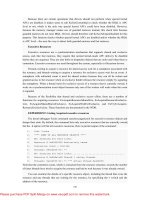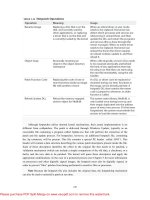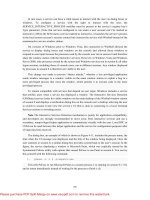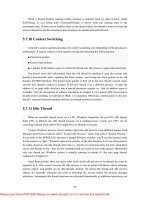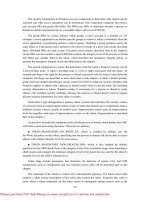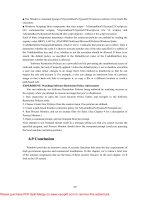windows internals 5th edition
Bạn đang xem bản rút gọn của tài liệu. Xem và tải ngay bản đầy đủ của tài liệu tại đây (18.12 MB, 1,262 trang )
5
FIFTH
EDITION
Mark E. Russinovich
and David A. Solomon
with Alex Ionescu
Windows
®
Internals
Covering Windows Server
®
2008
and Windows Vista
®
Foreword by Ben Fathi
Corporate Vice President, Windows Core Development, Microsoft Corporation
www.it-ebooks.info
PUBLISHED BY
Microsoft Press
A Division of Microsoft Corporation
One Microsoft Way
Redmond, Washington 98052-6399
Copyright © 2009 by David Solomon (all); Mark Russinovich (all)
All rights reserved. No part of the contents of this book may be reproduced or transmitted in any form or by any means
without the written permission of the publisher.
Library of Congress Control Number: 2009927697
Printed and bound in the United States of America.
1 2 3 4 5 6 7 8 9 QWT 4 3 2 1 0 9
Distributed in Canada by H.B. Fenn and Company Ltd.
A CIP catalogue record for this book is available from the British Library.
Microsoft Press books are available through booksellers and distributors worldwide. For further infor mation about
international editions, contact your local Microsoft Corporation office or contact Microsoft Press International directly at
fax (425) 936-7329. Visit our Web site at www.microsoft.com/mspress. Send comments to
Microsoft, Microsoft Press, Access, Active Directory, ActiveSync, ActiveX, Aero, Authenticode, BitLocker, DirectX,
Excel, Hyper-V, Internet Explorer, MS, MSDN, MS-DOS, Outlook, PowerPoint, ReadyBoost, ReadyDrive, SideShow, SQL
Server, SuperFetch, Visual Basic, Visual C++, Visual Studio, Win32, Windows, Windows Media, Windows NT, Windows
Server, Windows Vista, and Xbox are either registered trademarks or trademarks of the Microsoft group of companies.
Other product and company names mentioned herein may be the trademarks of their respective owners.
The example companies, organizations, products, domain names, e-mail addresses, logos, people, places, and events
depicted herein are fictitious. No association with any real company, organization, product, domain name, e-mail address,
logo, person, place, or event is intended or should be inferred.
This book expresses the author’s views and opinions. The information contained in this book is provided without any
express, statutory, or implied warranties. Neither the authors, Microsoft Corporation, nor its resellers, or distributors will
be held liable for any damages caused or alleged to be caused either directly or indirectly by this book.
Acquisitions Editor: Ben Ryan
Developmental Editor: Devon Musgrave
Project Editor: John Pierce
Editorial Production: Curtis Philips, Publishing.com
Cover: Tom Draper Design
Body Part No. X14-95072
www.it-ebooks.info
To Jim Allchin, our OS and rock star
www.it-ebooks.info
www.it-ebooks.info
v
Table of Contents
Foreword xix
Acknowledgments xxi
Introduction xxiii
1 Concepts and Tools 1
Windows Operating System Versions 1
Foundation Concepts and Terms 2
Windows API 2
Services, Functions, and Routines 4
Processes, Threads, and Jobs 5
Virtual Memory 14
Kernel Mode vs. User Mode 16
Terminal Services and Multiple Sessions 19
Objects and Handles 21
Security 22
Registry 23
Unicode 23
Digging into Windows Internals 24
Reliability and Performance Monitor 25
Kernel Debugging . . . . . . . . . . . . . . . . . . . . . . . . . . . . . . . . . . . . . . . . . . . . . . 26
Windows Software Development Kit 31
Windows Driver Kit 31
Sysinternals Tools 32
Conclusion 32
www.microsoft.com/learning/booksurvey/
What do you think of this book? We want to hear from you!
www.it-ebooks.info
vi
Table of Contents
2 System Architecture 33
Requirements and Design Goals 33
Operating System Model 34
Architecture Overview 35
Portability 38
Symmetric Multiprocessing 39
Scalability 43
Differences Between Client and Server Versions 43
Checked Build 47
Key System Components 49
Environment Subsystems and Subsystem DLLs 50
Ntdll.dll 57
Executive 58
Kernel 61
Hardware Abstraction Layer 65
Device Drivers 68
System Processes 74
Conclusion 83
3 System Mechanisms 85
Trap Dispatching 85
Interrupt Dispatching 87
Exception Dispatching 114
System Service Dispatching . . . . . . . . . . . . . . . . . . . . . . . . . . . . . . . . . . . . . 125
Object Manager 133
Executive Objects 136
Object Structure 138
Synchronization 170
High-IRQL Synchronization 172
Low-IRQL Synchronization 177
System Worker Threads 198
Windows Global Flags 200
Advanced Local Procedure Calls (ALPCs) 202
Kernel Event Tracing 207
Wow64 211
Wow64 Process Address Space Layout 211
System Calls 212
Exception Dispatching 212
www.it-ebooks.info
Table of Contents
vii
User Callbacks 212
File System Redirection 212
Registry Redirection and Reflection 213
I/O Control Requests 214
16-Bit Installer Applications 215
Printing 215
Restrictions 215
User-Mode Debugging 216
Kernel Support 216
Native Support 217
Windows Subsystem Support 219
Image Loader 220
Early Process Initialization 222
Loaded Module Database 223
Import Parsing 226
Post Import Process Initialization 227
Hypervisor (Hyper-V) 228
Partitions 230
Root Partition 230
Child Partitions 232
Hardware Emulation and Support 234
Kernel Transaction Manager 240
Hotpatch Support 242
Kernel Patch Protection 244
Code Integrity 246
Conclusion 248
4 Management Mechanisms 249
The Registry 249
Viewing and Changing the Registry 249
Registry Usage 250
Registry Data Types 251
Registry Logical Structure 252
Transactional Registry (TxR) 260
Monitoring Registry Activity 262
Registry Internals 266
Services 281
Service Applications 282
The Service Control Manager 300
www.it-ebooks.info
viii
Table of Contents
Service Startup 303
Startup Errors 307
Accepting the Boot and Last Known Good 308
Service Failures 310
Service Shutdown 311
Shared Service Processes 313
Service Tags 316
Service Control Programs 317
Windows Management Instrumentation 318
Providers 319
The Common Information Model and the Managed Object
Format Language 320
Class Association 325
WMI Implementation 327
WMI Security 329
Windows Diagnostic Infrastructure 329
WDI Instrumentation 330
Diagnostic Policy Service 330
Diagnostic Functionality 332
Conclusion 333
5 Processes, Threads, and Jobs 335
Process Internals 335
Data Structures 335
Kernel Variables 342
Performance Counters 343
Relevant Functions 344
Protected Processes 346
Flow of CreateProcess 348
Stage 1: Converting and Validating Parameters and Flags 350
Stage 2: Opening the Image to Be Executed 351
Stage 3: Creating the Windows Executive Process Object
(PspAllocateProcess) 354
Stage 4: Creating the Initial Thread and Its Stack and Context 359
Stage 5: Performing Windows Subsystem–Specific
Post-Initialization 360
Stage 6: Starting Execution of the Initial Thread 362
Stage 7: Performing Process Initialization in the Context of the
New Process 363
www.it-ebooks.info
Table of Contents
ix
Thread Internals 370
Data Structures 370
Kernel Variables 379
Performance Counters 379
Relevant Functions 380
Birth of a Thread 380
Examining Thread Activity 381
Limitations on Protected Process Threads 384
Worker Factories (Thread Pools) 386
Thread Scheduling 391
Overview of Windows Scheduling 391
Priority Levels 393
Windows Scheduling APIs 395
Relevant Tools 396
Real-Time Priorities 399
Thread States 400
Dispatcher Database 404
Quantum 406
Scheduling Scenarios 413
Context Switching 418
Idle Thread 418
Priority Boosts 419
Multiprocessor Systems 434
Multiprocessor Thread-Scheduling Algorithms 442
CPU Rate Limits 444
Job Objects . . . . . . . . . . . . . . . . . . . . . . . . . . . . . . . . . . . . . . . . . . . . . . . . . . . . . . . . 445
Conclusion 450
6 Security 451
Security Ratings 451
Trusted Computer System Evaluation Criteria 451
The Common Criteria 453
Security System Components 454
Protecting Objects 458
Access Checks 459
Security Descriptors and Access Control 484
Account Rights and Privileges 501
Account Rights 502
www.it-ebooks.info
x
Table of Contents
Privileges 503
Super Privileges 509
Security Auditing 511
Logon 513
Winlogon Initialization 515
User Logon Steps 516
User Account Control 520
Virtualization 521
Elevation 528
Software Restriction Policies 533
Conclusion 535
7 I/O System 537
I/O System Components 537
The I/O Manager 539
Typical I/O Processing 540
Device Drivers 541
Types of Device Drivers 541
Structure of a Driver 547
Driver Objects and Device Objects 550
Opening Devices 555
I/O Processing 562
Types of I/O 563
I/O Request to a Single-Layered Driver 572
I/O Requests to Layered Drivers 578
I/O Cancellation 587
I/O Completion Ports 592
I/O Prioritization 598
Driver Verifier 604
Kernel-Mode Driver Framework (KMDF) 606
Structure and Operation of a KMDF Driver 607
KMDF Data Model 608
KMDF I/O Model 612
User-Mode Driver Framework (UMDF) 616
The Plug and Play (PnP) Manager 619
Level of Plug and Play Support 620
Driver Support for Plug and Play 621
www.it-ebooks.info
Table of Contents
xi
Driver Loading, Initialization, and Installation 623
Driver Installation 632
The Power Manager 636
Power Manager Operation 638
Driver Power Operation 639
Driver and Application Control of Device Power 643
Conclusion 644
8 Storage Management 645
Storage Terminology 645
Disk Drivers 646
Winload 646
Disk Class, Port, and Miniport Drivers 647
Disk Device Objects 650
Partition Manager 651
Volume Management 652
Basic Disks 653
Dynamic Disks 656
Multipartition Volume Management 661
The Volume Namespace 667
Volume I/O Operations 674
Virtual Disk Service 675
BitLocker Drive Encryption 677
BitLocker Architecture 677
Encryption Keys 679
Trusted Platform Module (TPM) 681
BitLocker Boot Process 683
BitLocker Key Recovery 684
Full Volume Encryption Driver 686
BitLocker Management 687
Volume Shadow Copy Service 688
Shadow Copies 688
VSS Architecture 688
VSS Operation 689
Uses in Windows 692
Conclusion 698
www.it-ebooks.info
xii
Table of Contents
9 Memory Management 699
Introduction to the Memory Manager 699
Memory Manager Components 700
Internal Synchronization 701
Examining Memory Usage 701
Services the Memory Manager Provides 704
Large and Small Pages 705
Reserving and Committing Pages 706
Locking Memory 707
Allocation Granularity 708
Shared Memory and Mapped Files 709
Protecting Memory 711
No Execute Page Protection 713
Copy-on-Write 718
Address Windowing Extensions 719
Kernel-Mode Heaps (System Memory Pools) . . . . . . . . . . . . . . . . . . . . . . . . . . . 721
Pool Sizes 722
Monitoring Pool Usage 724
Look-Aside Lists 728
Heap Manager 729
Types of Heaps 730
Heap Manager Structure 731
Heap Synchronization 732
The Low Fragmentation Heap 732
Heap Security Features 733
Heap Debugging Features 734
Pageheap 735
Virtual Address Space Layouts 736
x86 Address Space Layouts 737
x86 System Address Space Layout 740
x86 Session Space 740
System Page Table Entries 744
64-Bit Address Space Layouts 745
64-Bit Virtual Addressing Limitations 749
Dynamic System Virtual Address Space Management 751
System Virtual Address Space Quotas 756
User Address Space Layout 757
www.it-ebooks.info
Table of Contents
xiii
Address Translation 761
x86 Virtual Address Translation 762
Translation Look-Aside Buffer 768
Physical Address Extension (PAE) 769
IA64 Virtual Address Translation 772
x64 Virtual Address Translation 773
Page Fault Handling 774
Invalid PTEs 775
Prototype PTEs 776
In-Paging I/O 778
Collided Page Faults 779
Clustered Page Faults 779
Page Files 780
Stacks 784
User Stacks 785
Kernel Stacks 786
DPC Stack 787
Virtual Address Descriptors 787
Process VADs 788
Rotate VADs 790
NUMA 791
Section Objects 792
Driver Verifier 799
Page Frame Number Database 803
Page List Dynamics 807
Page Priority 809
Modified Page Writer 812
PFN Data Structures 814
Physical Memory Limits 818
Windows Client Memory Limits 819
Working Sets 822
Demand Paging 823
Logical Prefetcher 823
Placement Policy 827
Working Set Management 828
Balance Set Manager and Swapper 831
System Working Set 832
Memory Notification Events 833
www.it-ebooks.info
xiv
Table of Contents
Proactive Memory Management (SuperFetch) 836
Components 836
Tracing and Logging 838
Scenarios 840
Page Priority and Rebalancing 840
Robust Performance 843
ReadyBoost 844
ReadyDrive 845
Conclusion 847
10 Cache Manager 849
Key Features of the Cache Manager 849
Single, Centralized System Cache 850
The Memory Manager 850
Cache Coherency 850
Virtual Block Caching 852
Stream-Based Caching 852
Recoverable File System Support 853
Cache Virtual Memory Management 854
Cache Size 855
Cache Virtual Size 855
Cache Working Set Size 856
Cache Physical Size 858
Cache Data Structures 859
Systemwide Cache Data Structures 860
Per-File Cache Data Structures 862
File System Interfaces 868
Copying to and from the Cache 869
Caching with the Mapping and Pinning Interfaces 870
Caching with the Direct Memory Access Interfaces 872
Fast I/O 873
Read Ahead and Write Behind 875
Intelligent Read-Ahead 875
Write-Back Caching and Lazy Writing 877
Write Throttling 885
System Threads 886
Conclusion 887
www.it-ebooks.info
Table of Contents
xv
11 File Systems 889
Windows File System Formats . . . . . . . . . . . . . . . . . . . . . . . . . . . . . . . . . . . . . . . . 890
CDFS 890
UDF 891
FAT12, FAT16, and FAT32 891
exFAT 894
NTFS 895
File System Driver Architecture 895
Local FSDs 896
Remote FSDs 897
File System Operation 901
File System Filter Drivers 907
Troubleshooting File System Problems 908
Process Monitor Basic vs. Advanced Modes 908
Process Monitor Troubleshooting Techniques 909
Common Log File System 910
NTFS Design Goals and Features 918
High-End File System Requirements 918
Advanced Features of NTFS 920
NTFS File System Driver 934
NTFS On-Disk Structure 937
Volumes 937
Clusters 937
Master File Table 938
File Reference Numbers 942
File Records 942
File Names 945
Resident and Nonresident Attributes 948
Data Compression and Sparse Files 951
The Change Journal File . . . . . . . . . . . . . . . . . . . . . . . . . . . . . . . . . . . . . . . . 956
Indexing 960
Object IDs 961
Quota Tracking 962
Consolidated Security 963
Reparse Points 965
Transaction Support 965
www.it-ebooks.info
xvi
Table of Contents
NTFS Recovery Support 974
Design 975
Metadata Logging 976
Recovery 981
NTFS Bad-Cluster Recovery . . . . . . . . . . . . . . . . . . . . . . . . . . . . . . . . . . . . . 985
Self-Healing 989
Encrypting File System Security 990
Encrypting a File for the First Time 993
The Decryption Process 998
Backing Up Encrypted Files 999
Conclusion 1000
12 Networking 1001
Windows Networking Architecture 1001
The OSI Reference Model 1001
Windows Networking Components 1003
Networking APIs 1006
Windows Sockets 1006
Winsock Kernel (WSK) 1012
Remote Procedure Call 1014
Web Access APIs 1018
Named Pipes and Mailslots 1021
NetBIOS 1027
Other Networking APIs 1030
Multiple Redirector Support 1033
Multiple Provider Router 1034
Multiple UNC Provider 1037
Name Resolution 1039
Domain Name System 1039
Windows Internet Name Service 1039
Peer Name Resolution Protocol 1039
Location and Topology 1042
Network Location Awareness (NLA) 1042
Link-Layer Topology Discovery (LLTD) 1043
Protocol Drivers 1044
Windows Filtering Platform (WFP) 1047
NDIS Drivers 1053
Variations on the NDIS Miniport 1057
Connection-Oriented NDIS 1057
www.it-ebooks.info
Table of Contents
xvii
Remote NDIS 1060
QoS 1062
Binding 1064
Layered Network Services 1066
Remote Access 1066
Active Directory 1066
Network Load Balancing 1068
Distributed File System and DFS Replication 1069
Conclusion 1071
13 Startup and Shutdown 1073
Boot Process 1073
BIOS Preboot 1073
The BIOS Boot Sector and Bootmgr 1077
The EFI Boot Process 1086
Initializing the Kernel and Executive Subsystems 1088
Smss, Csrss, and Wininit 1094
ReadyBoot 1099
Images That Start Automatically 1100
Troubleshooting Boot and Startup Problems 1101
Last Known Good 1101
Safe Mode 1101
Windows Recovery Environment (WinRE) 1106
Solving Common Boot Problems 1109
Shutdown 1115
Conclusion 1118
14 Crash Dump Analysis 1119
Why Does Windows Crash? 1119
The Blue Screen 1120
Troubleshooting Crashes 1124
Crash Dump Files 1125
Crash Dump Generation 1130
Windows Error Reporting 1131
Online Crash Analysis 1133
Basic Crash Dump Analysis 1134
Notmyfault 1134
Basic Crash Dump Analysis 1135
Verbose Analysis 1137
www.it-ebooks.info
xviii
Table of Contents
Using Crash Troubleshooting Tools 1139
Buffer Overrun, Memory Corruptions, and Special Pool 1140
Code Overwrite and System Code Write Protection 1143
Advanced Crash Dump Analysis 1144
Stack Trashes 1145
Hung or Unresponsive Systems 1147
When There Is No Crash Dump 1150
Conclusion 1152
Glossary 1153
Index 1185
www.microsoft.com/learning/booksurvey/
What do you think of this book? We want to hear from you!
www.it-ebooks.info
xix
Foreword
It’s both a pleasure and an honor for me to write the foreword for this latest edition of
Windows Internals. Many significant changes have occurred in Windows since the last edition
of the book, and David, Mark, and Alex have done an excellent job of updating the book to
address them. Whether you are new to Windows internals or an old hand at kernel develop-
ment, you will find lots of detailed analysis and examples to help improve your understand-
ing of the core mechanisms of Windows as well as the general principles of operating system
design.
Today, Windows enjoys unprecedented breadth and depth in the computing world. Variants
of the original Windows NT design run on everything from Xbox game consoles to desktop
and laptop computers to clusters of servers with dozens of processors and petabytes of stor-
age. Advances such as hypervisors, 64-bit computing, multicore and many-core processor
designs, flash-based storage, and wireless and peer-to-peer networking continue to provide
plenty of interesting and innovative areas for operating system design.
One such area of innovation is security. Over the past decade, the entire computing indus-
try—and Microsoft in particular—has been confronted with huge new threats, and security
has become the top issue facing many of our customers. Attacks such as Blaster and Sasser
threatened to bring the entire Internet to its knees, and Windows was at the eye of the hur-
ricane. It was obvious to us that we could no longer afford to do business as usual, as many
of the usability and simplicity features designed into Windows were being used to attack it
for nefarious reasons. At first the hackers were teenagers trying to gain notoriety by breaking
into systems or adding graffiti to a corporate Web site, but pretty soon the attacks intensified
and went underground. The hackers became more sophisticated and evaded inspection. You
rarely see headlines about viruses and worms these days, but make no mistake—botnets and
identity theft are big business today, as are industrial and government espionage through
targeted attacks.
In January 2002, Bill Gates sent his now-famous “Trustworthy Computing” memorandum to
all Microsoft employees. It was a call to action that resonated well and charted the course
for how we would build software and conduct business over the coming years. Nearly the
entire Windows engineering team was diverted to work on Windows XP SP2, a service pack
dedicated almost entirely to improving the security of the operating system. The Security
Development Lifecycle (SDL) was developed and applied to all Microsoft products, with
particular emphasis on Windows Vista as the first version of the operating system designed
from the ground up to be secure. SDL specifies strict guidelines and processes for secure
software development. Sophisticated tools have been developed to scan everything from
source code to system binaries to network protocols for common security vulnerabilities.
Every time a new security vulnerability is discovered, it is analyzed, and mitigations are devel-
oped to address that potential attack vector. Windows Vista has now been in the market for
www.it-ebooks.info
xx
Foreword
two years, and it is by far the most secure version of Windows. Some industry analysts have
pointed out that it is, in fact, the most secure general purpose operating system shipping
today.
The Windows team has continued to innovate over the past few years. Windows XP, Windows
Server 2003, Windows Server 2003 R2, Windows XP SP2, Windows Vista, Windows Server
2008, and Hyper-V are all major accomplishments and great successes—as well as great addi-
tions to the Windows family of products.
Frankly, I can’t think of a more exciting and challenging topic. Nor can I think of a more
authoritative and well-written book. David, Mark, and Alex have done a thorough job of dis-
secting the Windows architecture and providing diagnostic tools for hands-on learning. I
hope you enjoy reading and learning about Windows as much as we all enjoy working on it.
Ben Fathi
Corporate Vice President, Windows Core Development
Microsoft Corporation
www.it-ebooks.info
xxi
Acknowledgments
We dedicate this edition to Jim Allchin, our executive sponsor and champion before he
retired from Microsoft. Jim supported our book work on this and earlier editions and was
instrumental in bringing Mark Russinovich to Microsoft. In addition to shepherding Windows
Vista out the door, Jim also oversaw the delivery of Windows 2000, Windows XP, and
Windows Server 2003.
Each edition of this book has to acknowledge Dave Cutler, Senior Technical Fellow and the
original architect of Windows NT. Dave originally approved David Solomon’s source code
access and has been supportive of his work to explain the internals of Windows through his
training business as well as during the writing of the editions of this book.
We also thank three developers at Microsoft for contributing content that was incorporated
into this edition:
Christian Allred,
N
who wrote detailed descriptions on transactional NTFS (TxF) internals,
data structures, and behaviors
Stone Cong,
N
who wrote content and created diagrams about the Common Log File
System (CLFS)
Adrian Marinescu,
N
who updated his heap manager section in the memory manage-
ment chapter
This book wouldn’t contain the depth of technical detail or the level of accuracy it has with-
out the input, and support of key members of the Windows development team. We want to
thank the following people, who provided technical review and input to the book:
Dmitry Anipko Kwan Hyun Ravi Mumulla Jon Schwartz
Eugene Bak Mehmet Iyigun Adi Oltean Valerie See
Karlito Bonnevie Philippe Joubert Vince Orgovan Matt Setzer
Jon Cargille Kwan Hyun Kim Bernard Ourghanlian Andrey Shedel
Dean DeWhitt Kinshuman Kinshumann Alexey Pakhunov Neeraj Singh
Apurva Doshi Alex Kirshenbaum Milos Petrbok Vikram Singh
Joseph East Norbert Kusters Daniel Pravat Paul Sliwowicz
Tahsin Erdogan Jeff Lambert Ravi Pudipeddi John Stephens
Cenk Ergan Paul Leach Melur Raghuraman Deepu Thomas
Osman Ertugay Scott Lee Ramu Ramanathan J. R. Tipton
Tom Fout Mark Lloyd Vlad Sadovsky Davis Walker
Nar Ganapathy Karan Mehra Dragos Sambotin Brad Waters
Robin Giese Derek Moore Jamie Schwartz Bruce Worthington
www.it-ebooks.info
xxii
Acknowledgments
Thanks also to Daniel Pearson (who teaches Windows internals for Dave Solomon) for his
review and input.
Others might have contributed by answering questions in the hallway or cafeteria or by pro-
viding technical material—if we missed you, please forgive us!
The authors would like to thank Ilfak Guilfanov of Hex-Rays (www.hex-rays.com) for the IDA
Pro Advanced and Hex-Rays licenses for Alex Ionescu for his use in speeding his reverse
engineering of the Windows kernel. Alex chose not to have Windows source code access (as
did Mark Russinovich before he joined Microsoft) to research the information for his work on
this book, and these tools greatly facilitated his work. IDA’s features turn reverse engineer-
ing into a powerful tool for understanding Windows internals. Combined with the Hex-Rays
Decompiler, this analysis becomes even faster and more refined, as C code is directly pre-
sented instead of assembler, including all the right types.
Thanks also to Matt Ginzton of VMware, who arranged for Alex and David to receive VMware
Workstation to use in their research for the book. VMware Workstation was used instead of
Microsoft Virtual PC because of its support for 64-bit guests and multiple snapshots with
nonpersisent disks. (These features are now supported by Hyper-V, Microsoft’s new server
virtualization offering, but at the time of writing, this support was not available).
Thanks to Mike Vance of AMD for providing Dave Solomon’s AMD64 laptop for use in his
book research and live classes.
Finally, we want to thank the team at Microsoft Press who helped turn this book from idea
into reality:
Ben Ryan (acquisitions editor at Microsoft Press) for shepherding another edition of this
N
great book
Kathleen Atkins (project editor) and Devon Musgrave (developmental editor) for
N
launching and overseeing the project
Andrea Fox (proofreader), Curtis Philips (project and production manager), and John
N
Pierce (project editor and copyeditor) for laboriously going through all our chapters to
tighten up text, find inconsistencies, and keep the manuscript to the high standards of
Microsoft Press
Alex Ionescu, Mark Russinovich, and David Solomon
May 2009
www.it-ebooks.info
xxiii
Introduction
Windows Internals, Fifth Edition is intended for advanced computer professionals (both devel-
opers and system administrators) who want to understand how the core components of
the Windows Vista and Windows Server 2008 operating systems work internally. With this
knowledge, developers can better comprehend the rationale behind design choices when
building applications specific to the Windows platform. Such knowledge can also help devel-
opers debug complex problems. System administrators can benefit from this information as
well, because understanding how the operating system works “under the covers” facilitates
understanding the performance behavior of the system and makes troubleshooting system
problems much easier when things go wrong. After reading this book, you should have a
better understanding of how Windows works and why it behaves as it does.
Structure of the Book
The first two chapters (“Concepts and Tools” and “System Architecture”) lay the foundation
with definitions and explanations of terms and concepts used throughout the rest of the
book. The next two chapters—“System Mechanisms” and “Management Mechanisms”—
describe key underlying mechanisms in the system. The next eight chapters explain the core
components of the operating system: processes, threads, and jobs; security; the I/O system;
storage management; memory management; the cache manager; file systems; and network-
ing. The last two chapters cover startup and shutdown process and crash dump analysis.
History of the Book
This is the fifth edition of a book that was originally called Inside Windows NT (Microsoft
Press, 1992), written by Helen Custer (prior to the initial release of Microsoft Windows NT 3.1).
Inside Windows NT was the first book ever published about Windows NT and provided key
insights into the architecture and design of the system. Inside Windows NT, Second Edition
(Microsoft Press, 1998) was written by David Solomon. It updated the original book to cover
Windows NT 4.0 and had a greatly increased level of technical depth. Inside Windows 2000,
Third Edition (Microsoft Press, 2000) was authored by David Solomon and Mark Russinovich.
It added many new topics, such as startup and shutdown, service internals, registry inter-
nals, file system drivers, and networking. It also covered kernel changes in Windows 2000,
such as the Windows Driver Model (WDM), Plug and Play, power management, Windows
Management Instrumentation (WMI), encryption, the job object, and Terminal Services.
Windows Internals, Fourth Edition was the Windows XP and Windows Server 2003 update
www.it-ebooks.info
xxiv
Introduction
and added more content focused on helping IT professionals make use of their knowledge of
Windows internals, such as using key tools from Windows Sysinternals (www.microsoft.com/
technet/sysinternals) and analyzing crash dumps.
Fifth Edition Changes
This latest edition has been updated to cover the kernel changes made in Windows Vista
and Windows Server 2008. Hands-on experiments have been updated to reflect changes
in tools, and newly added experiments use tools not available when the fourth edition was
written. Additionally, content has been added to cover mechanisms that were not previously
described, such as the image loader and user-mode debugging facility, and information
about previously covered subjects has been expanded as well.
Hands-On Experiments
Even without access to the Windows source code, you can glean much about Windows
internals from tools such as the kernel debugger and tools from Sysinternals and Winsider
Seminars & Solutions (www.winsiderss.com). When a tool can be used to expose or demon-
strate some aspect of the internal behavior of Windows, the steps for trying the tool yourself
are listed in “Experiment” boxes. These appear throughout the book, and we encourage you
to try these as you’re reading—seeing visible proof of how Windows works internally will
make much more of an impression on you than just reading about it will.
Topics Not Covered
Windows is a large and complex operating system. This book doesn’t cover everything rele-
vant to Windows internals but instead focuses on the base system components. For example,
this book doesn’t describe COM+, the Windows distributed object-oriented programming
infrastructure, or the .NET Framework, the foundation of managed code applications.
Because this is an internals book and not a user, programming, or system administration
book, it doesn’t describe how to use, program, or configure Windows.
A Warning and a Caveat
Because this book describes undocumented behavior of the internal architecture and opera-
tion of the Windows operating system (such as internal kernel structures and functions), this
www.it-ebooks.info
Introduction
xxv
content is subject to change between releases. (External interfaces, such as the Windows API,
are not subject to incompatible changes.)
By “subject to change,” we don’t necessarily mean that details described in this book will
change between releases, but you can’t count on them not changing. Any software that uses
these undocumented interfaces might not work on future releases of Windows. Even worse,
software that runs in kernel mode (such as device drivers) and uses these undocumented
interfaces might experience a system crash when running on a newer release of Windows.
Find Additional Content Online
As new or updated material becomes available that complements this book, it will be posted
online on the Microsoft Press Online Developer Tools Web site. The type of material you
might find includes updates to book content, articles, links to companion content, errata,
sample chapters, and more. This Web content is available at www.microsoft.com/learning/
books/online/developer and is updated periodically.
Support
Every effort has been made to ensure the accuracy of this book. Should you run into any
problems or issues, please refer to the sources listed below.
From the Authors
This book isn’t perfect. No doubt it contains some inaccuracies, or possibly we’ve omitted
some topics we should have covered. If you find anything you think is incorrect, or if you
believe we should have included material that isn’t here, please feel free to send e-mail to
Updates and corrections will be posted on the Web site http://technet.
microsoft.com/en-us/sysinternals/bb963901.aspx.
From Microsoft Press
Microsoft Press provides corrections for books through the World Wide Web at the following
address:
www.microsoft.com/mspress/support
www.it-ebooks.info




